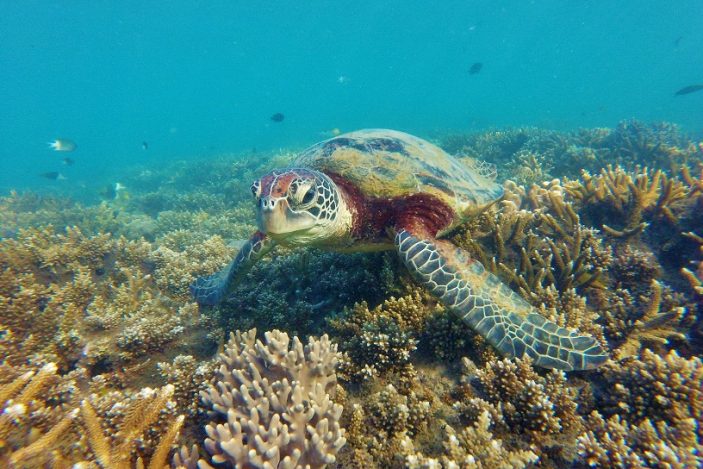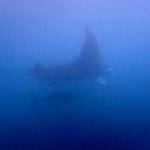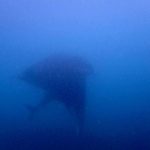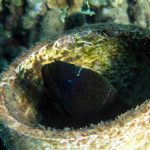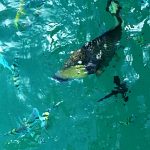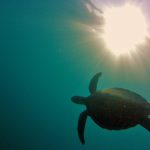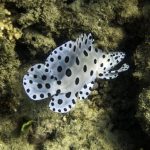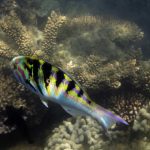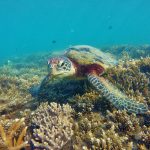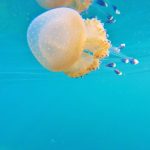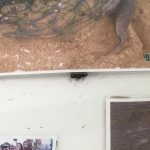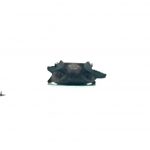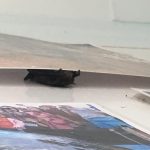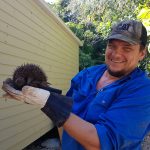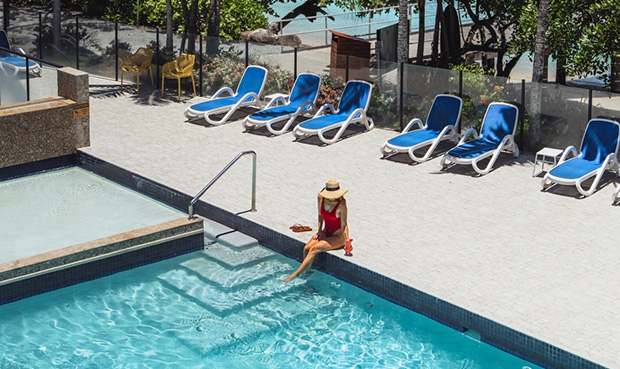Wow- what can I say about July? This month has truly been dominated by marine sightings. The whales are back and being sighted with some regularity from the beach, on the Fast Cat transfers and even from the Lighthouse! A Manta Ray has also been frequently spotted in both Welcome Bay and around the corner at Shark Fin Bay. Guests on the Glass Bottom Boat tours have been lucky enough to spot this magnificent creature as it careens through the water- on one particularly memorable sighting it was being closely followed by a small Reef Shark that was seeking shelter under its massive girth. One extremely pale Lionfish has been reported hanging around the jetty at night (I’m not lucky enough to have seen it yet) and one very hungry Giant Trevally interrupted a fish feed by determinately zooming after the various fish in a desperate bid to grab a quick bite for himself. He disappeared as soon as Titus appeared. Titus is a Titan Triggerfish that used to come to the fish feeds and then disappeared for a few months. Over the last week he has started attending feeds every day. The first day that he arrived was really special- I had been away for a few days and on my first fish feed back I not only had Titus but Radagast, my all time favourite fish (a Black Damsel Fish) arrived for the first (and only) time with a FRIEND! To have Radagast attend a fish feed is always a treat but for him to bring a slightly smaller friend in tow was unconceivable. Unfortunately his little chum has not made a return visit. We have also had several of the Blue Lined Parrotfish attending the fish feeds- and the Happy Moments are back in their droves! It started last month when a mysterious group of peach and black juveniles started attending the feed. I could not work out what they were for the life of me but over the weeks their colours developed further until they were undeniably Happy Moments. When they had just matured they were still not able to use their camouflage reflex (when stimulated Happy Moments turn from a brown body with yellowish head to motley dark and light brown all over) but as the weeks progressed and they matured further suddenly a well-placed handful of pellets turn them into a well-sprinkled collection of camouflage! It’s pretty cool to watch how quickly they can change colours.
Photos: Look closely and you can see this Manta Ray is not alone! Photos by Yukon, courtesy of Cairns Dive Centre
And of course if that is the action above the water you can just imagine what it has been like beneath the surface! Without exaggeration I believe this month has seen some of the best snorkelling of the year. Turtles have been abound, the Picasso Triggerfish and Six Bar Wrasse have been abundant (these are incredibly colourful beauties). Everywhere you turn there is something new to look at- though perhaps one of the most adorable was the baby Clownfish. Some only 1cm long!!! They are so tiny they are hard to catch on camera as they dart so quickly around their protective anemone homes. On one particularly memorable snorkelling trip I overdid it slightly by staying out for over three hours. By the time I came in I had lost a decent amount of skin from four of my toes. That trip took place near the start of the month and my feet are still healing! On the plus side I finally identified this unusual phenomenon that was first brought to my attention over a month ago. These clear (ish) solid ‘balls’ washed up on the beach and while I could tell they were not eggs they were a little reminisce of Neptune’s Necklace; a bubbly-type of seaweed found down south. However I was a little thrown by the fact that these ‘bubbles’ were clearly individual and had no sign of breakage from a larger plant structure such as tufts of green filaments trailing behind. It was a really noodle-scratcher! Shortly after the first guest asked me about it,some of the staff started reported seeing silver ‘balls’ while snorkelling. I really wasn’t sure what I was dealing with- until I finally saw my first ‘ball’ for myself – and I would have missed it if Natasha our Night Manager had not pointed it out to me. Finally the puzzle was solved! Somewhat ironically these bubbly sort of balls that reminded me of seaweed are in fact a type of algae- called Bubble Algae! Bubble Algae, or Valonia ventricose, tend to grow individually and are found throughout the world’s tropical and subtropical oceans. It is actually one of the largest single-celled organisms in existence and they thrive in tidal zones and are often found growing in coral rubble; although individual Bubble Algae have been found up to 80m deep which is pretty impressive for something that takes its energy from sunlight! They are not always silver but can appear green, black or even in some case, a beautiful teal colour. The colour itself is determined by the sheer number of chloroplast held within the individual specimen. The surface shines like a glass under water. They are actually surprisingly pretty once you start to notice them.
Photos (Left to Right): An eel seeks shelter from a broken pipe (photo by Natasha Runcevich). Titus and Radagast ate nearly all of the fish food between the two of them (photo by Jen Moloney). Bubble Algae (photo by Natasha Runcevich- who has promised to teach me how to edit photos!) One of many turtle sightings for the month (photo by David Butler)
Photos (Left to Right): You had to be unlucky to snorkel without finding a turtle this month (photo by David Butler). This juvenile Panther Grouper makes for a striking sight! (photo by Natasha Runcevich). The White Spotted Jellyfish is an incredibly beautiful filter feeder (photo by David Butler) and the Six Bar Wrass is notoriously difficult to photograph but well worth the effort (photo by Natasha Runcevich)
Another underwater treat this month was discovered by Dave in the opening days of July. If you haven’t met Dave yet he is one of our Food and Beverage Attendants who is always happily planning his next adventure to explore the island and its reef. Dave ran across a White Spotted Jellyfish- a truly beautiful specimen that is easily recognised by the large semi-transparent (rounded) bell covered in evenly spaced white dots. Picture a jellyfish with white chicken pox and you’ve got it! These stunning jellyfish are also called the Floating Bell or the Australian Spotted Jellyfish. Their scientific name is Phyllorhiza punctata. White Spotted Jellyfish have extremely mild venom- so mild in fact that they can’t use it to really harm anything. These are filter feeders that live on zooplankton that they pluck from the water. Basically they direct the flow of water over clusters of ‘mouthlets’ and use these structures to remove the microscopic zooplankton from the water column. The feeding process is continuous as the jellyfish has to keep a continuous flow of water in order to move the prey to different mouthlets for digestion. White Spotted Jellyfish are actually quite unique for jellyfish in that the initial stage of their lifecycle – the polyp stage –is asexual. Individuals reproduce by multiplying itself various times; this unusual method generates a much larger polyp hatch than the original the mother created. It is only once the specimen has developed into the Medusa stage of its cycle that it becomes sexually reproductive. The male shoots his sperm into the water and the female collects the sperm in her mouthlets and filter them to her reproductive organs (you can see that mouthlets are extraordinarily helpful things to these jellyfish!) There the fertilised growths form into polyps that are eventually dropped to the bottom of the ocean to begin their own asexual reproduction.
Another cool sighting was made by Natasha our water-loving Night Manager. Natasha snaps a photo of a gorgeous juvenile Panther Grouper she discovered lurking on the reef one day. When this little fella grows he will reach up to 70cm and have a distinctive hunched back. The hunched-shapes is the result of the laterally compressed body that is relatively tall combined with a concave profile and elongated snout. Juveniles like this one have a white background with round black spots while the adults have various body colouration using grey and beige combined with darker blotches of variable sizes across the body. It is a combination of the body shape and the colouration that makes this fish so easy to identify. This species (Cromileptes altivelis) is also known as the Humpback Grouper or the Australian Barramundi Cod. It tends to live in clear waters around lagoons and reefs and is usually found in a range of depth between 2 and 40m where they feast on smaller fish and crustaceans. They are ambush predators that tend to live solitary lives; excepting periods of mating. As with many fish species (including the humble Clownfish) the Humpback Grouper is able to change sex as it develops. They are actually listed as Vulnerable on the IUCN Red List of Threatened Species because they are a naturally rare-occurring species- which makes Natasha’s discovery all the better!
All in all the marine life has been pretty darn special this month but we had two very adorable terrestrial sightings that are worth a mention. The first occurred when I was wrapping up a Turtle Tour one day. I was standing there pointing to specific pictures telling the story of one of our turtles when I suddenly noticed a tiny hairy face peeping at me from beneath one of our posters. It was none other than an ill-placed Microbat trying to get a bit of shut eye during the day! Unfortunately for the little critter the wall behind it was so smooth it kept slipping lower and having to readjust itself. It was gripping the laminated edge pretty tightly trying to stay put but it eventually gave up. By the time I returned on the next tour it had departed. Fortunately I was able to get some photos of the adorable little fella’s face beforehand. Don’t worry- I didn’t use a flash. If you press on a specific space on the I-phones screen as you take a photo it will adjust the aperture to the spot you picked. By doing this I was able to get the photo to take enough details of the bat that you could actually see its face- but all the other details washed out in a blaze of light from the aperture being open so long. Microbats are adorable- they are often spotted zipping about the lights like a half-drunken moth. The general rule of thumb with Bats is that they ‘are what they eat’. I.E. Fruit bats have a sweet tooth (they like nectar and fruits) so they have a sweet face. Microbats on the other hand eat insects so they have a face only a mother could love. Although looking at this little guys he does look pretty darn adorable!
And for the most exciting news of the month- a female Short Nose Echidna turned up again! This beautiful little girl was discovered in the construction site much to the delight of the men working there. She was an unexpected but thoroughly prized discovery- although her stay was brief and they quickly relocated her into the jungle so that she wouldn’t get hurt.
Photos (Left to Right): Peek-A-Boo! A tiny little face peers out from beneath a poster at the Turtle Rehabilitation Centre. Upon closer inspection it belonged to an adorable Microbat (photos by Jen Moloney). Frank was pretty delighted by the unexpected visitor found in his construction site (photo by anonymous)
After such an incredible month I can’t wait to see what August will bring us!
Jen Moloney – Marine Biologist & Tours Co-Ordinator
tourguide@fitzroyisland.com


